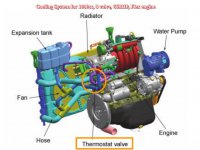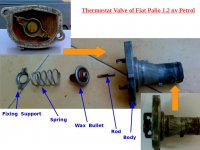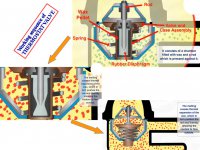Navin Talati
Member
- Joined
- Oct 23, 2006
- Messages
- 106
- Points
- 97
THERMOSTAT VALVE – A key component in Engine Cooling System.
If we broadly look into the process of engine cooling, the air injected into the engine is mixed with the injected fuel and burns in the engine cylinders. The energy generated from the combustion produces power for the engine, with surplus energy transferred to the surrounding environment; the engine block, oil and coolant. The cooling system helps to maintain the temperature of an engine under appropriate limits. The cooling system consists of mainly following components:
(1). Water pump,
(2). Engine,
(3). Radiator,
(4). Fan,
(5). Expansion tank,
(6). Thermostat valve,
(7). Coolant and
(8). Hoses
A fundamental test of the cooling system is the Air to Boil (ATB) test, which represents the ability of the coolant to form bubbles. For the ATB test to be effective, vehicle characteristics such as weight, maximum load and the country (for climate and altitude parameters) where the vehicle is to be sold. The ATB index represents the maximum temperature that the cooling system supports before the coolant begins to boil. If the temperature exceeds this limit, the cooling system should be better dimensioned or the maximum load of the vehicle should be reduced. In Fiat,s cases a one-dimensional model of the coolant in the engine was developed using Flowmaster V7 (a Simulation software) to estimate the airflow through the radiator. The model was developed to determine the effects of the flow of fluids, predicting the internal flow and thermal effects through the use of mathematical and empirical relationships of pressure, flow and temperature. The characteristics of some of the components were provided by the component suppliers. The simulation results were validated by the comparison with experimental data obtained in the climate chamber. The model developed is used in the design of cooling systems at Fiat, helping to understand the effects of engine heat rejection, thermal efficiency of the radiator and fan performance in the cooling system of the vehicle. This is just a superficial information for the general knowledge.
Let us focus our discussion to the Thermostat Valve. To get the best efficiency of the car engine, the combustion process must continue under controlled parameters at a particular constant temperature. That temperature is acquired by the heat generated due to friction and exothermic reaction called combustion of the fuel. During the working, the heat is continuously generated but it is regulated by the Thermostat Valve (TV). The TV neither allows to cool the engine nor heat – its main function is to keep the engine at a designed constant temperature.
Surfing the detail and googling, I came to know some astonishing but dangerous information that many technicians at some workshops either advises the customers to remove the inner valve from TV to prevent over heating indication on the temperature dial ! ! Or, some times they may carryout the same job while servicing outside the knowledge of the customer. After such By-passing of the TV, they guarantees that henceforth the Temperature Indicator will never go too high. - Assured! - The fact is that thus they make engine to run at lower temperature and hence compromising all other technical parameters of the car engine.
A thermostat in a car, regulates the temperature of the engine by allowing engine coolant to circulate between the engine and radiator. The thermostat is a mechanical valve that opens and closes, either allowing coolant to circulate or not to varying degrees according to the temperature. The engine operates most efficiently between certain temperatures. Too cold and it wastes fuel, too hot and it can be damaged, sometimes permanently. The thermostat is there to keep the coolant/cooling water from circulating from the engine through the radiator until the water that surrounds the engine (sometimes called the cooling jacket) reaches a per-determined temperature. It is important not to run the engine for long periods with a bad thermostat (or with no thermostat), because this can cause overheating if it is stuck closed, and reduced gas mileage if it is stuck open. Also, if you need to change your thermostat, be sure to replace it with one that opens at the recommended temperature for the engine. Another side effect of a thermostat that is stuck open is that your car heater will take longer to warm up because the heater takes it's water from the engine, not from the radiator. So if the engine is cooling prematurely, then the water stays colder longer.
Location of TV is Generally near the engine and the upper hose that runs to the radiator. Its operating temperature of initial opening is encoded in almost all types of thermostats. In consideration of the tolerance deviation of ± 2ºC, the thermostat starts to open between 78ºC and 82ºC, and should be completely opened at 95ºC, with a course or displacement of at least 8 mm or round about as per the design.
When it does not work, either it remains OPENED, causing High fuel consumption and pollutant emission, low power and torque or it remain CLOSED, causing the engine to over-heat, burning the cylinder’s head gasket, warping of the cylinder’s head.
For maintenance, look at the following major point:
Ensure that correct thermostat is matched to correct vehicle model specification.
Never perform maintenance repair while the cooling system is hot. There is a great risk of burning injury.
Immediately park vehicle in a safe place and turn engine off, if there is evidence of excessive temperature.
Check the cooling fluid level weekly, with the engine cold.
Always use the specified cooling fluid and the correct rating.
Do not top-up the cooling system with pure water. This will dilute the ethylene glycol concentration.
Any reduction in the cooling fluid level indicates leaks in the cooling system.
Perform preventive maintenance of thermostats every 30 000 Km
You may refer the animation on working of the Car Cooling System at
for detail. Some pictures also I am giving of dismantled thermostat valve of fiat palio 1,2 nv petrol. In Fiat's may models the TV design either remains the same or very similar.
Corrections, additions and comments will be highly appreciated about the above topic for our mutual knowledge.
Thanks to all.
Navin Talati / 06-02-2016
If we broadly look into the process of engine cooling, the air injected into the engine is mixed with the injected fuel and burns in the engine cylinders. The energy generated from the combustion produces power for the engine, with surplus energy transferred to the surrounding environment; the engine block, oil and coolant. The cooling system helps to maintain the temperature of an engine under appropriate limits. The cooling system consists of mainly following components:
(1). Water pump,
(2). Engine,
(3). Radiator,
(4). Fan,
(5). Expansion tank,
(6). Thermostat valve,
(7). Coolant and
(8). Hoses
A fundamental test of the cooling system is the Air to Boil (ATB) test, which represents the ability of the coolant to form bubbles. For the ATB test to be effective, vehicle characteristics such as weight, maximum load and the country (for climate and altitude parameters) where the vehicle is to be sold. The ATB index represents the maximum temperature that the cooling system supports before the coolant begins to boil. If the temperature exceeds this limit, the cooling system should be better dimensioned or the maximum load of the vehicle should be reduced. In Fiat,s cases a one-dimensional model of the coolant in the engine was developed using Flowmaster V7 (a Simulation software) to estimate the airflow through the radiator. The model was developed to determine the effects of the flow of fluids, predicting the internal flow and thermal effects through the use of mathematical and empirical relationships of pressure, flow and temperature. The characteristics of some of the components were provided by the component suppliers. The simulation results were validated by the comparison with experimental data obtained in the climate chamber. The model developed is used in the design of cooling systems at Fiat, helping to understand the effects of engine heat rejection, thermal efficiency of the radiator and fan performance in the cooling system of the vehicle. This is just a superficial information for the general knowledge.
Let us focus our discussion to the Thermostat Valve. To get the best efficiency of the car engine, the combustion process must continue under controlled parameters at a particular constant temperature. That temperature is acquired by the heat generated due to friction and exothermic reaction called combustion of the fuel. During the working, the heat is continuously generated but it is regulated by the Thermostat Valve (TV). The TV neither allows to cool the engine nor heat – its main function is to keep the engine at a designed constant temperature.
Surfing the detail and googling, I came to know some astonishing but dangerous information that many technicians at some workshops either advises the customers to remove the inner valve from TV to prevent over heating indication on the temperature dial ! ! Or, some times they may carryout the same job while servicing outside the knowledge of the customer. After such By-passing of the TV, they guarantees that henceforth the Temperature Indicator will never go too high. - Assured! - The fact is that thus they make engine to run at lower temperature and hence compromising all other technical parameters of the car engine.
A thermostat in a car, regulates the temperature of the engine by allowing engine coolant to circulate between the engine and radiator. The thermostat is a mechanical valve that opens and closes, either allowing coolant to circulate or not to varying degrees according to the temperature. The engine operates most efficiently between certain temperatures. Too cold and it wastes fuel, too hot and it can be damaged, sometimes permanently. The thermostat is there to keep the coolant/cooling water from circulating from the engine through the radiator until the water that surrounds the engine (sometimes called the cooling jacket) reaches a per-determined temperature. It is important not to run the engine for long periods with a bad thermostat (or with no thermostat), because this can cause overheating if it is stuck closed, and reduced gas mileage if it is stuck open. Also, if you need to change your thermostat, be sure to replace it with one that opens at the recommended temperature for the engine. Another side effect of a thermostat that is stuck open is that your car heater will take longer to warm up because the heater takes it's water from the engine, not from the radiator. So if the engine is cooling prematurely, then the water stays colder longer.
Location of TV is Generally near the engine and the upper hose that runs to the radiator. Its operating temperature of initial opening is encoded in almost all types of thermostats. In consideration of the tolerance deviation of ± 2ºC, the thermostat starts to open between 78ºC and 82ºC, and should be completely opened at 95ºC, with a course or displacement of at least 8 mm or round about as per the design.
When it does not work, either it remains OPENED, causing High fuel consumption and pollutant emission, low power and torque or it remain CLOSED, causing the engine to over-heat, burning the cylinder’s head gasket, warping of the cylinder’s head.
For maintenance, look at the following major point:
Ensure that correct thermostat is matched to correct vehicle model specification.
Never perform maintenance repair while the cooling system is hot. There is a great risk of burning injury.
Immediately park vehicle in a safe place and turn engine off, if there is evidence of excessive temperature.
Check the cooling fluid level weekly, with the engine cold.
Always use the specified cooling fluid and the correct rating.
Do not top-up the cooling system with pure water. This will dilute the ethylene glycol concentration.
Any reduction in the cooling fluid level indicates leaks in the cooling system.
Perform preventive maintenance of thermostats every 30 000 Km
You may refer the animation on working of the Car Cooling System at
for detail. Some pictures also I am giving of dismantled thermostat valve of fiat palio 1,2 nv petrol. In Fiat's may models the TV design either remains the same or very similar.
Corrections, additions and comments will be highly appreciated about the above topic for our mutual knowledge.
Thanks to all.
Navin Talati / 06-02-2016




